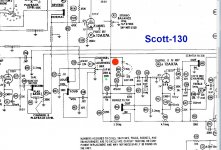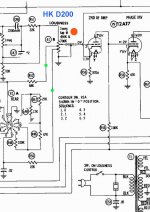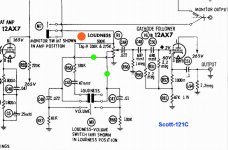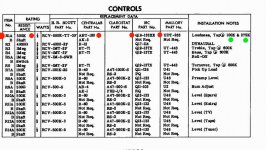good afternoon everybody,
I guess all of you know how important the proper functioning of a volume potentiometer is in a preamplifier, and of course many faced the problem of replacing old and scratchy pot with a new one, when there are absolutely no modern pots with the tap(s) at the right points available, there are too many solutions to mention, but there is one that I personally like the most, and feel that this is the right thing, a modern 47 step attenuator by Goldpoint Level Controls , very well made and smooth turning.
I`ve bought it because it is pretty easy to solder the tap(s) to any desired point(s), and I wouldn`t ask for help here, if I was 100% sure where these points were.
the original Harman Kardon Citation One preamplifier contains a dual 500K/500K potentiometer with 2 (two) taps, HK part # is RV3285193 (if anybody would like to sell an old used one, I would gladly buy it)
unfortunately, my unit came to me heavily molested, with not original "alps" pot of 100K (!) instead of original, 200K balance pot had also been replaced with 500K (?), so I can`t pull it out and measure, there is nothing to measure.
surely I wrote to HK, and surely they don`t know and don`t have the older papers.
then I wrote to the very famous and respectable gentlemen, who are indeed great masters in restoring HK apparatus, Jim McShane, Don Sachs and Sheldon Stokes, latter provided a fantastic replacement power supply kit, all of them say that if I`m to use a modern logarythmic pot,and would want to use loudness feature (I would), I should make only one tap at about 70K and solder the 27K resistors to it, as it was in original, and leave the other tap that went to 100K resistors not used at all.
they are probably quite right, and maybe this will work fine, but still I want to understand what the other tap they suggest not to use was for?
so I know now, (not 100% though) that the original RV3285193 had two taps at 70K and 250K, but was it logarythmic or linear? this is a crucial question, because I`ve already spent a month selecting zero tolerance resistors for the attenuator to make, but what if the original was linear, and that other 250K tap was just to make it pseudo-logarythmic?
summing all said, I would be very, very grateful for your opinion on the following questions:
if the original RV3285193 500K/500K pot with taps at 70K and 250K was LOGARYTHMIC, what was the second tap that went to 100K resistors for?
if the original pot was LINEAR, was that second tap to 100K resistors called upon to make it logaryhmic-like, just because they didn`t have the logarythmic pots available?
what will happen if I make a LOGARYTHMIC stepped attenuator of 500K/500K and use BOTH taps at 70K and 250K, soldering them to the original points?
would it be better (true to specs) if I make a LINEAR stepped attenuator of 500K/500K and use BOTH taps at 70K and 250K, soldering them to the original points?
I wouldn`t ask for help, but while searching for some replacement pot I found this guy:
Harman Kardon Citation I IV 1 4 loundess volume pot control potentiometer | eBay
he claims that he sells an EXACT COPY of original pot, but we know now, that the original has 2 taps at 70K and 250K, and this one he sells has only one tap at 150K. where is the truth?
it seems that the same questions can be asked about many other preamplifiers of the era with the same problems with scratchy pots, e.g. Scott-130, that I also own, there is again a 500K/500K potentiometer with TWO taps at 200K and 350K, was it linear or logarythmic?
and again that ebay guy claims he sells an "EXACT COPY" of the original, but what he sells again have only ONE pot at 250K :
Volume pot control power switch on/off Scott 299 299A 130 120-CP 120A 380 355 | eBay
I guess all of you know how important the proper functioning of a volume potentiometer is in a preamplifier, and of course many faced the problem of replacing old and scratchy pot with a new one, when there are absolutely no modern pots with the tap(s) at the right points available, there are too many solutions to mention, but there is one that I personally like the most, and feel that this is the right thing, a modern 47 step attenuator by Goldpoint Level Controls , very well made and smooth turning.
I`ve bought it because it is pretty easy to solder the tap(s) to any desired point(s), and I wouldn`t ask for help here, if I was 100% sure where these points were.
the original Harman Kardon Citation One preamplifier contains a dual 500K/500K potentiometer with 2 (two) taps, HK part # is RV3285193 (if anybody would like to sell an old used one, I would gladly buy it)
unfortunately, my unit came to me heavily molested, with not original "alps" pot of 100K (!) instead of original, 200K balance pot had also been replaced with 500K (?), so I can`t pull it out and measure, there is nothing to measure.
surely I wrote to HK, and surely they don`t know and don`t have the older papers.
then I wrote to the very famous and respectable gentlemen, who are indeed great masters in restoring HK apparatus, Jim McShane, Don Sachs and Sheldon Stokes, latter provided a fantastic replacement power supply kit, all of them say that if I`m to use a modern logarythmic pot,and would want to use loudness feature (I would), I should make only one tap at about 70K and solder the 27K resistors to it, as it was in original, and leave the other tap that went to 100K resistors not used at all.
they are probably quite right, and maybe this will work fine, but still I want to understand what the other tap they suggest not to use was for?
so I know now, (not 100% though) that the original RV3285193 had two taps at 70K and 250K, but was it logarythmic or linear? this is a crucial question, because I`ve already spent a month selecting zero tolerance resistors for the attenuator to make, but what if the original was linear, and that other 250K tap was just to make it pseudo-logarythmic?
summing all said, I would be very, very grateful for your opinion on the following questions:
if the original RV3285193 500K/500K pot with taps at 70K and 250K was LOGARYTHMIC, what was the second tap that went to 100K resistors for?
if the original pot was LINEAR, was that second tap to 100K resistors called upon to make it logaryhmic-like, just because they didn`t have the logarythmic pots available?
what will happen if I make a LOGARYTHMIC stepped attenuator of 500K/500K and use BOTH taps at 70K and 250K, soldering them to the original points?
would it be better (true to specs) if I make a LINEAR stepped attenuator of 500K/500K and use BOTH taps at 70K and 250K, soldering them to the original points?
I wouldn`t ask for help, but while searching for some replacement pot I found this guy:
Harman Kardon Citation I IV 1 4 loundess volume pot control potentiometer | eBay
he claims that he sells an EXACT COPY of original pot, but we know now, that the original has 2 taps at 70K and 250K, and this one he sells has only one tap at 150K. where is the truth?
it seems that the same questions can be asked about many other preamplifiers of the era with the same problems with scratchy pots, e.g. Scott-130, that I also own, there is again a 500K/500K potentiometer with TWO taps at 200K and 350K, was it linear or logarythmic?
and again that ebay guy claims he sells an "EXACT COPY" of the original, but what he sells again have only ONE pot at 250K :
Volume pot control power switch on/off Scott 299 299A 130 120-CP 120A 380 355 | eBay
Attachments
Last edited:
The original seems to be a linear pot with a "law faking" 100k resistor from the upper tap.
Just ignore that when using a log taper replacement pot.
Just ignore that when using a log taper replacement pot.
Last edited:
Just ignore that when using a log taper replacement pot.
all right, that`s exactly what Jim McShane said, except that he didn`t say anything about the linearity.
I just want to understand as completely as possible- if original was linear, and I make 100% copy of it, but stepped with precision resistors, and use both taps as in original cirquit, will it be better than logarythmic or worse? the key question is that I want to keep the Contour (loudness) feature as close to original as I can.
some update:
here are the Harman Kardon D200 receiver and Scott-121C preamplifier just to compare, as can be seen the 1meg/1meg pot in HK D200 has 2 taps at 450K and 700K, and the Scott-121 500K/500K pot also has 2 taps, but at 100K and 275K (what a preciseness in an older 20% carbon potentiometer!)
and the same question- were these pots linear? and if they were, will it be BETTER in any way to build a 47 step attenuator, using 46 similar 10.9K 0.1% resistors (sums 501400 Ohm), soldering both taps at the very same pots as in original?
this will be the chain of film resistors, acting the same as the carbon resistive path in a pot, isn`t it? then the performance of the attenuator should be just as the HK and Scott engineers designed it, or am I wrong?
your suggestions are very much welcomed.
here are the Harman Kardon D200 receiver and Scott-121C preamplifier just to compare, as can be seen the 1meg/1meg pot in HK D200 has 2 taps at 450K and 700K, and the Scott-121 500K/500K pot also has 2 taps, but at 100K and 275K (what a preciseness in an older 20% carbon potentiometer!)
and the same question- were these pots linear? and if they were, will it be BETTER in any way to build a 47 step attenuator, using 46 similar 10.9K 0.1% resistors (sums 501400 Ohm), soldering both taps at the very same pots as in original?
this will be the chain of film resistors, acting the same as the carbon resistive path in a pot, isn`t it? then the performance of the attenuator should be just as the HK and Scott engineers designed it, or am I wrong?
your suggestions are very much welcomed.
Attachments
update:
original Scott-130 volume pot (RVCD-500K-TT-3F-SW) is 100% proved to be linear, so it seems that the second tap at 350K is called upon to make a pseudo logarythmic pot out of a linear one.
then one question still remains- will it be better in any way to make and exact copy of it, but stepped with a chain of similar precision resistors (which is easier), or make it logarythmic?
it seems strange that I`m trying to bring the real (indeed) American Heritage preamps as close to specs and retain their shining glory, and almost nobody among Americans say anything.
original Scott-130 volume pot (RVCD-500K-TT-3F-SW) is 100% proved to be linear, so it seems that the second tap at 350K is called upon to make a pseudo logarythmic pot out of a linear one.
then one question still remains- will it be better in any way to make and exact copy of it, but stepped with a chain of similar precision resistors (which is easier), or make it logarythmic?
it seems strange that I`m trying to bring the real (indeed) American Heritage preamps as close to specs and retain their shining glory, and almost nobody among Americans say anything.
Hello,
Citation I and some other older Harman Kardon's -- seem to have a bit of a reputation or lack there-of regarding the potentiometers - i.e. channel to channel(gang to gang), consistency in the control which necessitates a balance adjustment. Especially noticeable at low volume levels. I doubt if you would be happy if you found a used one.
Checking my own Citation I, with an analog meter it does seem logarithmic in circuit - also noticed significant lack of consistancy in resistance, channel to channel.
Per recent correspondence with McShane Enterprises, the correct replacement volume pot with tap has a logarithmic audio taper. The original pot with second tap that goes to the 100K resistor – was a “faking” tap used to convert a linear taper pot into an audio taper pot - so it is not needed or desired with the use of a modern log A pot. The 100k resistor can be taken out of circuit.
Good luck.
TiM
Citation I and some other older Harman Kardon's -- seem to have a bit of a reputation or lack there-of regarding the potentiometers - i.e. channel to channel(gang to gang), consistency in the control which necessitates a balance adjustment. Especially noticeable at low volume levels. I doubt if you would be happy if you found a used one.
Checking my own Citation I, with an analog meter it does seem logarithmic in circuit - also noticed significant lack of consistancy in resistance, channel to channel.
Per recent correspondence with McShane Enterprises, the correct replacement volume pot with tap has a logarithmic audio taper. The original pot with second tap that goes to the 100K resistor – was a “faking” tap used to convert a linear taper pot into an audio taper pot - so it is not needed or desired with the use of a modern log A pot. The 100k resistor can be taken out of circuit.
Good luck.
TiM
Tim,
thank you so much for your reply, I know I can use logarithmic pot, but the question was not about the possibility in general, it was about what would happen if I replace older scratchy 20% carbon pot with a modern stepped one, also linear, and use just the same two taps, making it just the same pseudo logarithmic.
there is an old thread, where people say, for example:
"In my experience most SS amps/recievers that used a passive form of loudness circuit used a linear pot. With a cap and resistor from the tap to ground with a switch across the cap (I'm ignoring the treble boost, most good loudness circuits do). In that configuration the linear pot behaves close to a log taper. Using a 100k log taper would make it difficult to get sufficient bass "boost" without using low resistor and high cap values and the resulting loss." - #9 here:
Volume Pot with 4 legs ?!!!
so I`m trying to understand not if I can use one or another, but what will be better, like in original or according to modern approach.
thank you so much for your reply, I know I can use logarithmic pot, but the question was not about the possibility in general, it was about what would happen if I replace older scratchy 20% carbon pot with a modern stepped one, also linear, and use just the same two taps, making it just the same pseudo logarithmic.
there is an old thread, where people say, for example:
"In my experience most SS amps/recievers that used a passive form of loudness circuit used a linear pot. With a cap and resistor from the tap to ground with a switch across the cap (I'm ignoring the treble boost, most good loudness circuits do). In that configuration the linear pot behaves close to a log taper. Using a 100k log taper would make it difficult to get sufficient bass "boost" without using low resistor and high cap values and the resulting loss." - #9 here:
Volume Pot with 4 legs ?!!!
so I`m trying to understand not if I can use one or another, but what will be better, like in original or according to modern approach.
- Home
- Amplifiers
- Tubes / Valves
- Harman Kardon Citation I loudness taps





